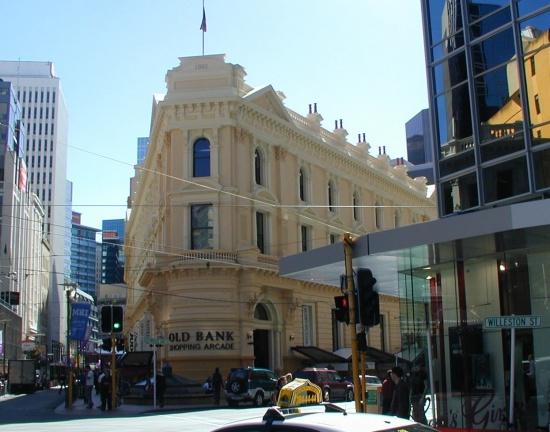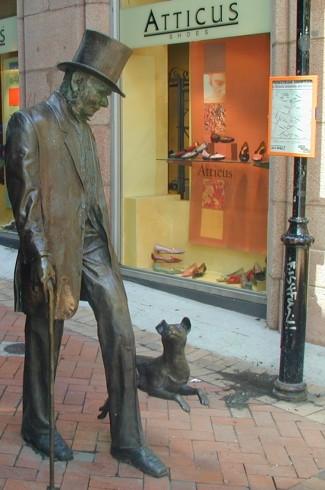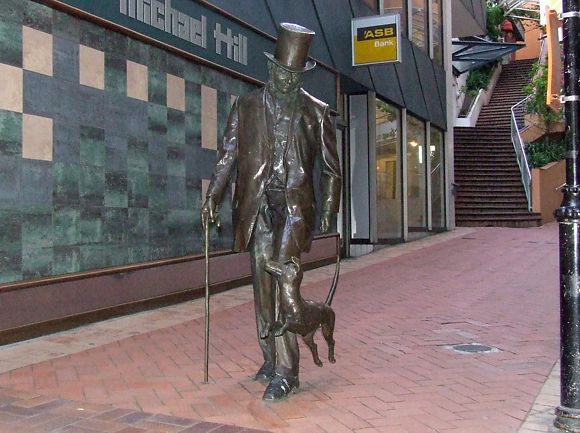|
Zeitblick
- Series
A HillAc Production |
|
City,
My City - Series One Part
3 In 1851 John Plimmer, known by history as the Father of Wellington, bought the wreck of a ship that had run aground on the eastern coast of Wellington Harbour out near The Heads at a place since named Inconstant Point. The vessel, the Inconstant, was on her way from Australia to Callao in Peru with a cargo of animal skins and tea and had "missed her stays" (failed to answer to the helm) when entering the harbour to replenish water supplies. The ship itself was a regular "production line" model built by George Old of Bras D'or Shipyards in Nova Scotia for functionality rather than aesthetics or speed. Indeed in some places the original bark of the birch trees from which she was built may be seen attached to the wooden members. Plimmer had the ship towed to the coast near the heart of Wellington and beached her below his house above Lambton Quay which was then the beach of Wellington Harbour. He arranged for a shop to be constructed on the beached hull and built a wharf from the land onto the deck for access. John Plimmer himself explains what took place: "After much trouble and no little expense we succeeded in placing her in the required position. When I had got her firmly fixed and secured in every possible way I cut down her upper works and built a large building over the hull, 68 feet by 30 feet. The Government allowed me to make a bonded store of the lower half and granted me a licence for it." Inconstant, known from then on as Plimmer's Ark, did not fulfill the role for which she had been designed and built but continued to play a part that would ensure she entered the collective consciousness and history of the city.
Up until the major earthquake of 1855 much of the hull of Plimmer's Ark was surrounded by water and other vessels were able to dock alongside to unload cargo and immigrants. The earthquake raised the shoreline about a meter making the water surrounding her too shallow and in 1856 a retaining wall was built around the north side of the hull using spoil from the hills above. In 1883 the structure on her deck was demolished and her ribs were cut down to ground level. In time the city grew and much of this growth was northwards into the sea that over the years, through reclamation, was to become dry land. As reclamation continued it covered the remains of the hull of Inconstant and by this act, the timbers of the ship were preserved from serious deterioration. During excavation of the foundations for the Bank of New Zealand Head Office on the corner of Lambton Quay and Customhouse Quay in 1899, some of these timbers were uncovered and portions taken to make Directors Chairs for the bank and one of these chairs is retained at the Alexander Turnbull Library. The building was completed in the grand style of the age and became one of the most imposing buildings in Lambton Quay but all sight was lost of the Inconstant for the next 88 years. As a boy I recall entering the building with my Grandmother whilst it was still a bank and of feeling dwarfed by its sheer size and grandeur with it's dark wood walls and black and white tiled floor. Many years later, in 1999, I met the Project Manager for the restoration of the Old Bank which was to turn it into a shopping precinct. Malcolm Macgregor took me on a personal guided tour of the renovation site and of the restoration process undertaken to preserve some ancient timbers found under the building. These timbers were none other than parts of the ship Inconstant. The remains were discovered (even though it was known that they lay there) and removed, with the exception of a portion of the bow which is now on display under a glass floor in the Vault Courtyard of the Old Bank. The rest of the ship was transported to Shed 21 on Wellington Wharf where it under-went the long and painstaking process of permanent preservation. I have had the privilege of viewing and touching these relics from the early days of Wellington City and of seeing the curiosities which were uncovered from the mud surrounding the ship. Along with the ships timbers a large number of artefacts were retrieved such as shoes, plates, bottles, buttons and lead shot which are now on permanent display on Wellington Wharf and in the Old Bank building itself.
And what of John Plimmer? He passed away in 1905 at the age of 92 but his name survives through the descendants of his 8 sons and 3 daughters. Plimmer is remembered in various Wellington land marks such as Plimmer's Ark, Plimmer Steps and Plimmer House. At the foot of Plimmer Steps, opposite the location of the Inconstant John Plimmer himself, cast in bronze along with his dog Fritz, his constant companion, maintains a fatherly watch over his beloved city. |
|
|
Like a presence from the past watching over his beloved Wellington, John Plimmer with his faithful dog Fritz stroll down 'Plimmers Lane' towards central Wellington. The steps behind them go up to Boulcott Street and trace the route taken by the original 'Plimmer Steps' which John Plimmer cut into the hill up to his house on the hillside. © Peter Wells, Wellington, New Zealand |



